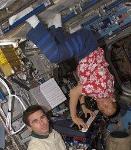
Podcasts |
|
The Elements of a MusicalPart of the series “Putting It Together: Words and Music and Musical Theater,” produced for ArtsEdge at the John F. Kennedy Center for the Performing Arts. A musical is not a cabaret show and it’s not an opera. It has distinct elements that must be present. In this piece Heather Nathans, Associate Professor of Theatre at the University of Maryland explains what those elements are. Listen here
|
|
Musical Theater – Where To?Part of the series “Putting It Together: Words and Music and Musical Theater,” produced for ArtsEdge at the John F. Kennedy Center for the Performing Arts. As the rock musical gave way to the spectacle musical, shows like “Cats,” “Phantom of the Opera” and “Starlight Express” came to rely less on story and more on technology. As a result, by the end of the 20th Century, musical theater was looking for a way to define itself. Heather Nathans, Associate Professor of Theatre at the University of Maryland talks about the changes in musical theater in the last forty years and where musical theater appears to be headed. Listen here
|
|
Disney and the MusicalPart of the series “Putting It Together: Words and Music and Musical Theater,” produced for ArtsEdge at the John F. Kennedy Center for the Performing Arts. In an odd turn, the Broadway music — exported by Walt Disney to cartoons in the 1930s — was returned to Broadway by Disney in the 1990s. Heather Nathans, Associate Professor of Theater at the University of Maryland explains this transition. Listen here
|
|
Write Your Own MusicalPart of the series “Putting It Together: Words and Music and Musical Theater,” produced for ArtsEdge at the John F. Kennedy Center for the Performing Arts. This podcast instructs a young person in what to think about when writing his or her own musical. It includes excerpts from an interview with Stephen Schwartz who wrote “Pippin,” “Godspell” and “Wicked.” Narrated by Heather Nathans, Associate Professor of Theater at the University of Maryland. |
|
The Mystery Behind the Mystery PlayPart of the series “From an Ill-Spun Wool: The Second Shepherds’ Play and Early English Theater,” produced for the Folger Shakespeare Library. A look at recent literary detective work into the true origins of The Second Shepherds’ Play. |
|
Medieval Mystery PlaysPart of the series “From an Ill-Spun Wool: The Second Shepherds’ Play and Early English Theater,” produced for the Folger Shakespeare Library. Scholars Theresa Coletti and Barbara Palmer talk about the vast world of early English theater — a sprawling heritage that’s still too often overlooked |
|
“What Space ‘Sounds’ Like”Part of the series “Arts/Space: Where Art & Outer Space Come Together,” produced for ArtsEdge at the John F. Kennedy Center for the Performing Arts. For as long as people have been putting words to music, they have tried to make the music express what they are talking about. While the idea of “outer space” is relatively new, people have been writing about the stars and the moon forever. This piece looks at the many ways artists have depicted “space” in music. The piece is narrated by Roger Launius of the Space History Division of the National Air and Space Museum, and features Miles Hoffman, commentator for NPR’s Morning Edition, John Dennis, who created the music for Disneyland’s Space Mountain, and Jonn Serrie, the nation’s leading composer of music for planetarium shows. Listen here
|
|
“Music in Space”Part of the series “Arts/Space: Where Art & Outer Space Come Together,” produced for ArtsEdge at the John F. Kennedy Center for the Performing Arts. Roger Launius of the Space History Division of the National Air and Space Museum talks with and/or plays the music of everyone who has ever played a musical instrument in space. It also talks with the NASA technician who is responsible for making sure that music instruments can be brought into space safely and played safely in space. Listen here
|
|
“A Lasting Legacy”Part of the series “Blues Journey,” produced for ArtsEdge at the John F. Kennedy Center for the Performing Arts. Musicologist Kip Lornell explains that Blues musicians who moved north tailored their music to reflect their new urban surroundings. Acoustic guitars gave way to electric guitars; and drums and stand-up bass rounded out the sound. Blues went electric — setting the stage for rhythm-and-blues and rock-‘n-roll. And with a little help from the radio and jukeboxes, the blues sound could be heard far and wide. Listen here
|
|
“Spreading the Joy of Blues”Part of the series “Blues Journey,” produced for ArtsEdge at the John F. Kennedy Center for the Performing Arts. Musicologist Kip Lornell explains that the blues sound was captured by Alan Lomax, who was among the first to record folk songs in the 1930s. Because of Lomax’s recordings, people across the country could hear the unique music of blues artists like Huddie Ledbetter (Leadbelly) and Muddy Waters for the first time. Listen here
|
|














